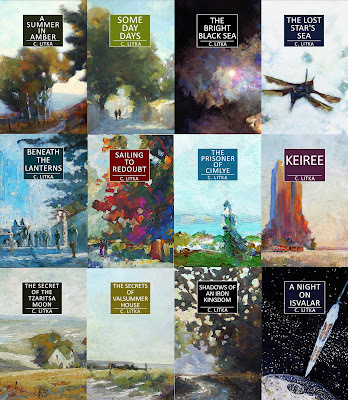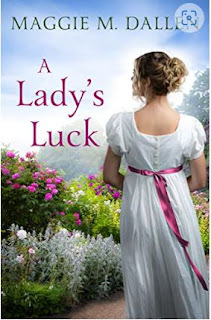C. Litka's Blog, page 33
October 21, 2022
The Quest, Part 3
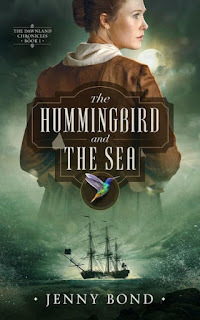 The great quest for a new genre, or two continues with three more books, a historical romance, a regency romance, and a gay mystery story.
The great quest for a new genre, or two continues with three more books, a historical romance, a regency romance, and a gay mystery story.The Hummingbird and the Sea by Jenny Bond DNF 54%
This novel opens on a summer’s day in 1716 in the Puritan society of a New England town. Our female main character, Maria, a daughter of the wealthy farmer, observes a stave fighting match between the local champion and a newcomer who has arrived to build the school. She finds herself immediately drawn to this newcomer, and falls in love with him over the next couple of days. However, her childhood friend, the son of the Puritan minister has just returned from Harvard where he was taught to be a minister as well, and expects to marry Maria. But having fallen for the buff new guy, and she declines to accept his proposal for marriage. The spurned lover discovers that the buff new guy is a deserter from a British warship and could be hanged, so our buff hero must flee, not before proposing to Maria and being accepted by her and her father. He flees with the husband of Maria’s older sister who has been scrapping by as a silversmith and wants to better himself financially. They head off to join a ship to find their fortunes in the Caribbean Sea. The spurned suitor, her childhood friend, then rapes Maria.
The story shifts to the Caribbean to follow our buff hero and his sidekick, the silversmith, where they fall in with pirates, and work their way up the chain of command until the buff hero has a pirate ship of his own and is making a good living at it. Our buff hero also falls in love with the young madam of a tavern/whorehouse, for the love triangle trope.
A Lady’s Luck by Maggie M Dallen C, on the curve
Unlike the previous story, this one has a Regency era female heroine who is standing on her own and supporting her useless brother. With the estate left in debt with the death of their parents, Henrietta as restored their fortune by betting on foibles of the English aristocracy. Don’t ask me how this works. I don’t think it’s a thing, but let's just go with it. An earl, with a lot of secrets to keep, including running a privateer, and supporting a brother who has faked his death to become an (anti-slavery) pirate gets involved with Henrietta on account of a bet she placed on whether or not he was the father of an actress' baby. Spark reluctantly fly, and this being a romance, the happy ever after ending is insured, though not being a steamy one, they only kiss on the pages. I’m not sure there’s an actual plot here, just a series of meeting at various locales. During their meetings the dialog is spaced out by paragraphs describing the thoughts of both the Earl and Henrietta making conversations hard to follow. But I guess it's their thoughts – do I? Don’t I? Should I? Shouldn’t I? What’s going on him/her/me?- that count here. Not my cup of tea again, no surprise to either you or me, but I guess it’s serviceable for the genre.
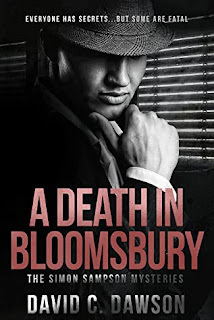
A Death in Bloombury, The Simon Sampson Mysteries Book 1 by David C Dawson C+
In my scowling through the free titles under “Historical Fiction” I came across this mystery book. And since it was set in 1932 London, it sounded promising. The hero, Simon Sampson is an ex-crime reporter for a London paper and now an announcer for the evening news on the BBC. He is also a homosexual. It turns out that David C. Dawson is an award winning author of gay mysteries and romances. This is a quest, and having looked into some female orientated fiction, why not gay?
Our hero, Simon Sampson, in this story discovers a dying lady in a London alley. He collects a few clues before running for help. But the lady is no longer there when he brings back the constable. Returning to the scene later, he and his pal discover some blueprints and some code in German hidden at the scene. The next day the police (possible fake) are cleaning up the scene and are very unhelpful. He turns to a lesbian friend “Bill” for help to translate the documents and things spiral out of control after that. Not wanting to give too many spoilers away, I’ll only say that while the story is well written, I did have some problems with it. Don’t I always?
First of all, though the author did do a lot of research into London of 1932 and some of the most famous personalities –however, perhaps because of that, the story seems to be told from the present day rather than from within the story. What I mean by that is that much of the color and background is introduced almost as a lecture. This includes not only about the background history, but about the life of homosexuals in England during this period, when it was a criminal offense to be one. In a historical story like this you need to create a world that the reader might be unfamiliar with, while the characters in the story the world would be commonplace. How do you get that background into the story while keeping what the characters see, think, and experience within the story authentic? It is hard, and I don’t think Dawson nailed it. As I said, he would introduce all these facts – from the lives of homosexuals, to that of Noel Coward, to National Socialism in Germany in too much detail that they seemed, as I said, like lectures instead of color and world building. But that might just be me, as a writer. Points off.
My second gripe is also a personal one. I really dislike it when murder mystery writers feel that they need to increase the body count from one to – in this case – four in order to ramp up the tension. I am quite sure that he could’ve written just as good of a story with only one murder. He did, however, make the subsequent murders mean something to the two main characters. But still. Points off.
This is not a “steamy” story, and can easily be read as a straight mystery adventure with the homosexual aspects of it just as an interesting spotlight on the hidden world of England in the 1930’s (to the, what, 1960’s when the decriminalized homosexual activity?). Still grading it on the pulp curve with my nitpicking I gave it a C+, however it could be a straight B grade adventure story for you, if your tastes are different than mine.
I have one more book to read in this first batch: Discerning Grace by Emma Lombard. It concerns a girl fleeing a forced marriage to a cruel old man in 1826 who, disguised as a boy, joins the Royal Navy.
But don’t despair, I have download a new batch of free novels, this time “Free Urban Fantasy Adventures.” Stay turned!
October 17, 2022
The Quest Continues (Part 2)
A couple of weeks ago I began a quest to discover a new genre of fiction to read, since I realized that my old stalwart, science fiction no longer appealed to me. I knew fantasy wasn't it either, so I decided to try historical fiction. I went on Amazon and downloaded nine books that came up under "Free Historical Fiction." I went with novels (and one novella) and cast my net wide. Below are two more of the books I tried.
But before I talk about them, a word about how I am rating these books. In my last installment of my quest, I mentioned that I was grading those books on the curve. I’ve given the subject a little more thought, and can now say with a little more precision just what I meant. Basically I'm reading them as pulp fiction. I’ve long seen books written primarily as ebooks primarily for selling on Amazon as being the 21st century version of pulp fiction. Those first books, and most of the ones going forward strike me as being written by people who were familiar with these books and said to themselves, "Heck, I can write stuff like this, just as good, if not better." So they did, and did. Not having read widely in these genre, I can't say if they are as good or better than most of the other books of their type, but I think I can safely say that I don’t detect any higher ambition in most (but not all) of these stories to be different than the other books in their chosen genre, so I will grade them all on that curve - pulp fiction stories. So let’s get on to the next two.
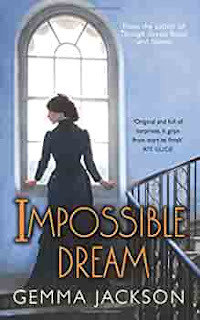
Impossible Dream by Gemma Jackson C+
This is a novel set in Dublin Ireland in 1899, and the story opens in a convent orphanage. Three of the 13 year old female orphans are selected to be placed, as servants, in the household of a lady who is related to one of the nuns. This was standard practice – the children would be trained as servants and their wages paid to the convent until they were 16. I expected their experiences would be the focus of the story, but once placed in the household they became secondary characters, as the focus of the story shifted to the woman of the house, the physically and mentally abused wife of a cruel sea captain and his five sons from previous marriage.
The basic plot is that wife, who had inherited and owns the house is being abused and starved by her cruel husband. This is possible because women of that age were powerless. The only thing she owned after marriage was the house and its fittings, otherwise she was dependent on her husband who controlled all the money, even the money she brought with her dowry. Her husband gets run over by a cart and loses both his legs. He is confined to a hospital, and the five sons go off to sea. However, the husband still controls the finances and he doesn’t give her any money, all the while blackening her reputation from the hospital. With the help of some old friends she gets her side of the story out and attracts the attention of some wealthy women who approach her with the idea of using her house as a school to train women fleeing from forced marriages, or virtual slavery, to train them to live on their own and make a living all on their own. The point of the story was to show just how totally dependent women were on men in that time. They could be used and abused as they will, with almost no options to make a respectable living all on their own.
I am not a student of history, and I assume that Jackson has done her homework, so I have no doubt that this was the case. And while there were likely men as cruel as those depicted in this story, I still felt that the cruelty and helplessness seemed a little over the top – but maybe that’s expected in the genre. The story, however, was more ambitiously written than some of the others, though incidents were introduced and then resolved rather quickly at times. Plus, being the first book in a series, it had the feel of just serving to set up more books rather than a standalone novel. While we followed the thoughts and actions of the wife, the supporting cast was little more than names to me. I skimmed at bit towards the end, as the lessons it wanted to impart got a bit repetitious. And in some ways, off message, as one of the thing these girls were being trained to do is to be come waitresses for the Harvey House Restaurants in the southwest of the U.S. at that time. The incentive t become these waitress at this chain of railroad restaurants, they would have the opportunity to land rich husbands, which were thick upon the ground in female starved west of the time. So much for independence.
All in all, not a bad book, clearly a subject close to the writer’s heart, hence my C+ rating on the curve, but not my cup of tea. I won't be going on in the series.
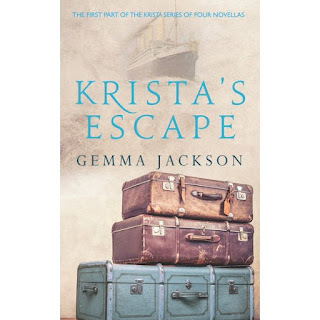
Krista’s Escape by Gemma Jackson DNF 5%
Though a random choice it turns out that this is a novella by the author of Impossible Dream. This time we find ourselves in the year 1938 in a French city on the border with Germany. The heroine, Krista, a young woman, is the daughter of an innkeeper. As you can see, I didn't get very far into it before I called it a day. I got as far as when she goes downstairs to make coffee and open the cafe. There she has to fight off the advances of a brutal Hitler Youth who intends to marry her and then she is verbally abused by her three brothers… I decided that I'd been there, read that. Apparently women being abused by men and escaping for a better life is either Ms Jackson’s or a genre’s trope. As I've said already, it's not my cup of tea, so I had no desire to continue on.
More adventures in "Free Historical Fantasy" this coming Friday with The Hummingbird and the Sea, A Lady's Luck, and A Death in Bloomsbury. Stay tuned!
October 14, 2022
So Long, Science Fiction
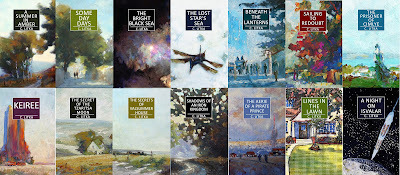
And thanks for all the fish!
This week one of the authors I follow on YouTube had an interview with a literary agent and invited questions. I had one. In my process of sending out query letters to agents, it struck me that even agents who claimed to be open to science fiction, it was fantasy that they really wanted. I am sending query letters from a list of agents who handled science fiction, and in this last batch, when I was filling out the submission form for one of those agents, it did not even offer me the option of classifying my story as science fiction. So my question was, was this apparent lack of interest in science fiction just in my imagination, or was it real?
According to this agent, it is very much real. Editors are far more open to fantasy than to science fiction stories. And indeed publishers who haven’t published science fiction or fantasy in the past are now interested in publishing fantasy. The reason this agent and the writer (of fantasy) suggested was that fantasy had become much more mainstream than science fiction due to popular shows like the Game of Thrones, the Lord of the Rings and more recent streaming fantasy stories. The agent suggested that science fiction still has a sort of nerdy vibe to it, pointing to the TV show The Expanse which had the scope and production values of a Game of Thrones but did not escape that science fiction niche.
Fantasy, it seems, simply has a wider appeal. For example, my 13 year old granddaughter is an avid fan of fantasy, and has been reading YA fantasy for the last three years. And while she is a big fan of the Star Wars universe, she’s even a bigger Lord of the Rings fan. I don’t think she has any great desire to branch out into science fiction. And, as I've mentioned before, YA SF doesn’t sell well, and compared to fantasy, there's not much of it published.
While I don’t write books to sell them, I would like to find my widest possible audience, and fantasy seems to offer a much greener pasture than science fiction. As I have noted in past posting I no longer have any loyalty to science fiction. I was never a true, dye-in-the-wool science fiction fan, in that I never liked SF short stories, and grand ideas don’t appeal to me. It was the exotic locales of science fiction that appealed to me. For my stories, I invent different worlds to tell old fashioned adventure stories. I don’t need SF to do that. I can write them as fantasies instead.
I don’t think I can bring myself to write stories with “real” magic, any more than I can bring myself to write stories with telepathy, teleportation, time travel, or things that seem no more possible to me than magic spells. Instead, as I have in one story already (Beneath the Lanterns), I will use Arthur C. Clarke’s observation that any science sufficiently advanced might appear to be magic as the basis of my fantasy. I don’t seem myself writing high fantasy, epic fantasy, or grimdark fantasy, but I do think that I can invent worlds and stories that look backwards into history, rather than forwards, like fantasy, but without magic systems and the grand scale that merely suggest magic (advanced science) and secrets, but keep them rare and unexplained. I think we’re talking about the “mundane” fantasy, but who knows?
Not, mind you, that I think it will make a great deal of a difference in either my stories or my success. It is simply a matter of slightly increasing the odds that more readers will find me. We’ll see.
October 7, 2022
A New Quest
Readers of my book reviews on this blog will be nodding their heads when I say that I need to find a new genre or two to read. I’ve sampled the best writers fantasy has to offer, and found them not to my taste. Science fiction isn’t really much better. One of the reasons I started writing was that I couldn’t find modern books that appealed to me, and that hasn’t changed. While I still follow science fiction blogs and YouTubers, I really don’t know why since I haven’t found anything that really interests me in years. It is time to move on.
But to what? I had been reading James Calvell’s Tai-Pan, which was okay, but failed to seal the deal, largely because of my need to have a comfortable companion in the story to tag along with. I didn’t click with Mr Tai-Pan. Still, it seemed that historical fiction of some sort might be a good starting point, so that’s what I have started my quest. To be more specific, “Free Historical Fiction” on Amazon. It was less daunting that trying to select a book off of a half dozen rows of books at the library.
Free historical fiction on Amazon will deliver a grab bag of genre and story lengths, from short stories to full novels, many of them teasers for series. Romance is a key element of at least the ones I selected. But I like a bit of romance in all my stories, so why not? I’ve read three so far. All of these books are published by some sort of traditional publishers of one sort or another.
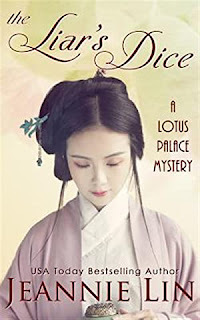
First off was Liar’s Dice, A Lotus Palace Mystery by Jeannie Lin, a novella of historical romance set in China’s Tang Dynasty period, that would be around 849 A.D. which teases a four book series. While the author claims to have extensively researched the period, that research is not to be found in this book, at least as far as making the world of the Tang Dynasty visible to this reader. Perhaps it is developed in greater detail and color in the novels. Like all three of the books I’ve read, this is written from a female point of view aimed primarily at female readers. I found it interesting enough just for that aspect alone, though as a mystery, our point of view character, the unmarried daughter of a wealthy family is not (yet) anyway, a Sherlock Holmes as she is involved in a murder that might involve her brother as well. There is, of course, a love interest that remains unresolved. I’d give it a “C” (on the curve).
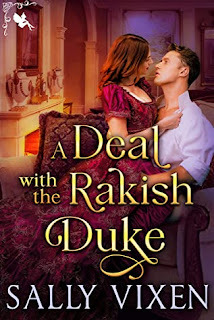
Next up was A Deal with the Rakish Duke, A Steamy Historical Regency Romance Novel by Sally Vixen. A determined “spinster” makes a deal with an infamous rake to pretend that they are a couple in order to dissuade a woman who insists on marrying the infamous rake. Of course he falls in love with her, and she him – and we find that the spinster is only 23 years old… Note that “steamy” means soft-core porn, erotica, so you get a couple of steamy scenes in your 163 pages. Porn Erotica from the woman’s point of view was interesting. It made me wonder what my wife thought of me – forty-five years ago… I suppose if you are named “Sally Vixen” you would probably be fated to write this sort of stuff. Like Liar’s Dice, there is not much of an attempt to set the story in Regency Era England except to have balls and dukes everywhere. I’d give it a “C” (again on the curve, as I am not its target audience)
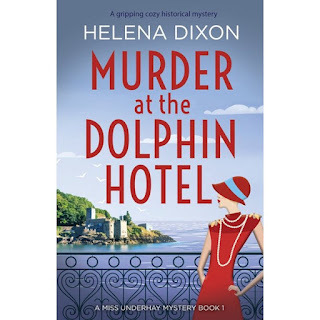
The third book is Murder at the Dolphin Hotel by Helena Dixon. This one is set in 1933 Dartmouth England. A young woman is put in charge of her grandmother’s hotel while gram goes to Scotland to tend to her elderly sister. The grandmother hires a rather mysterious man, to look after her hotel and granddaughter because someone is sending threatening letters about getting “what is rightfully theirs.” Unlike the first two books, Dixon does make an attempt to paint a picture of 1933 Dartmouth, though to be honest, I didn’t get much of authentic vibe.
Here is a most amusing passage: Kitty sighed and pulled out the visitor’s register. In a few seconds she beckoned Mattto come around to her side of the desk and view the page.
‘This is the man. Mr Briand Smith from Essex, room twenty-one on the second floor.’
He stood behind her to peer at the details. ‘Can you make me a copy of the register entry?’ He was close enough to smell the fresh soapy scent on her skin and to notice the tiny mole below her earlobe. Matt forced his attention to the screen and tried not to think about his proximity to Kitty or why she ruffled his senses so much. If you didn’t find it amusing, read it again.
It is my understanding that readers of historical fiction are pretty demanding when it comes to historical accuracy, and I have to admit that I’m with them there. If you are going to put your story into real history, it needs to be entirely immersed in it. In the case of this story, the author made a conscious to make the setting real – with less than complete success, at least for me. It had the flavor of a Google street view setting, which is to say, she tossed in a lot of details about Dartmouth, but they seemed superficial, things you might note looking at a modern street in street view. And, she had an elderly character apparently driving to Scotland in a motor car. This being 1933, there is no way an elderly lady would drive a car all the way to Scotland – driving was still a bit of an adventure in those days – plus the most common way to travel any distance in those days was by train. This, like the “screen” above show that the author has not been able to put the present day world entirely aside when writing this novel.
My other complaint, and this applies to almost all mysteries, is the number of murders mystery writers seemed compelled to include in their stories. I don’t know if writers are compelled to always write about murder – and add a few more as the story goes along – by readers, editors, or simply by laziness, since murder is, as the ultimate stakes, is an easy way to make things matter, and raise the stakes, as the story goes along. I stopped reading mysteries because this began to really annoy me. This story has three murders – three too many – in my opinion. An none of them at the Dolphin Hotel. One is off screen, before the story commences, and maybe could be justified by setting the stake, but the other two are clearly just tossed in an attempt to raise the stakes. One is of a long time employee of the hotel where the main character has lived since she was six years old, and her death seems to have had no effect on this character other than it is “horrible” or some such thing, which I found to be totally unrealistic, indicating t me that this murder was simply part of the formula, as understood by the author.
And just to be fair, I grabbed a copy of Dorothy L Sayers Clouds of Witness off my book shelf and read a page or two of it. It was, as I suspected, an order of magnitude better written. While Dixson uses language, Sayers commands it. That said, going in with low expectations, I guess it met them, so once again I have a grade of a “C” on a curve, but I won’t be reading further stories.
I’m almost tempted to keep reading the Sayers’ book, but perhaps I should continue on with my quest. The next one up is Impossible Dream by Gemma Jackson, an Irish writer.
September 28, 2022
The Aerie of a Pirate Prince Release Date: Sept. 29th 2022
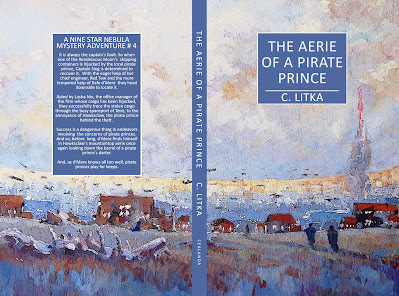
The fourth installment of the Nine Star Nebula Mystery/Adventure series featuring the adventures of Rafe d'Mere is set to be released on 29 September 2022. It will be a free ebook on Apple, Smashwords, B & N, Kobo, and Google, and cost $1.99 on Amazon. The paperback book will we available on Amazon for $7.99 and the free audio version will be available on the Google Play Store.
It is always the captain’s fault. So when a shipping container is offloaded to the wrong lighter – hijacked by the local crime syndicate – Captain Sing of the Rendezvous Moon knew she’s be blamed, even though they had followed all the proper procedures. She had no intention of being blamed. She intended to track the hijacked container down. Red Tew, her chief engineer, volunteered to accompany her as “muscle” and invited Rafe d’Mere to tag along as well, since he was an old hand at dealing with the pirate princes of the Alatzian System. Because he was an old hand in dealing with the pirate princes of the Alantzia, Rafe had no desire to have anything to do with pirate princes. But what could he say, but “I suppose so,” when invited along?
Captain Sing, Tew, d’Mere and his companion the crow Kee head down to Teire to locate the cargo container before its contents can be broken up and sent on the lawless drifts. There they are joined by an equally determined Lasha Nin, the office manager of the actual owner of the cargo. Together they trace the cargo through the busy space port of Teire, to the annoyance of the pirate prince behind the theft. Before he knows it, d’Mere is once again looking down the barrel of a pirate prince’s darter. Pirate princes play for keeps.
The Aerie of a Pirate Prince is a 40,600 word long story – either a long novella or a short novel.
C. Litka writes old fashioned stories with modern sensibilities, humor, and romance. He spins tales of adventure, mystery, and travel set in richly imagined worlds, with casts of colorful, fully realized characters. If you seek to escape your everyday life, you will not find better company, nor more wonderful worlds to travel and explore, than in the stories of C. Litka.
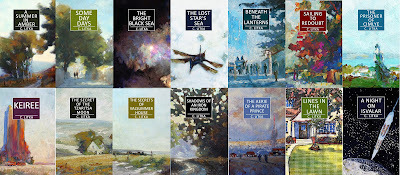
September 23, 2022
Ship of Magic Review
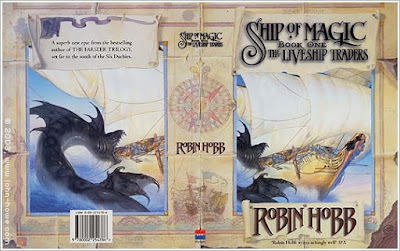
Ship of Magic (The Liveship Traders Trilogy Book 1) by Robin Hobb DNF (44%)
I must confess that I am no great fan of fantasy, despite the fact that I seem to have been reviewing a lot of fantasy recently. Blame that on the fact that TOR keeps offering me free ebooks, many of which are fantasy. In the case of this book, however, I picked it up from the library because Robin Hobbs is a very highly regarded writer, and this book in particular, because I like books about the sea.
Please note that in general my favorite books are written in first person, character focused, and are straight ahead narrative adventures. I enjoy clever, witty, writing that is in itself enjoyable. What I don’t like… well, I’ll go into that with the Ship of Magic.
Be careful what you wish for, since wishes sometimes come true. As I said above, I like character focused stories. Ship of Magic is a very, verycharacter focused story. So much so that it seemed more like a character study, a tableau rather than a story. I am certain that there’s a story somewhere in the deep weeds of the world building much of which is accomplished by theinternational dialog of her cast of characters.However, Ilost patience trying to find anything more than a slight, slowwisp of it as it crept along. The fact that I stuck with this story for 44% of it – and it’s a big book – is a testament to myhope of eventually finding the story. However, when I realized how much I was skim-reading this book, I gave up. If I ever find that I care enough, I’ll look it up on its Wikipedia entry. I haven’t so far.
Remember what I said about liking first person narratives – well this an omnipresent third person narrative. I generally don’t mind close third person narratives, but most omnipresent ones turn me off. In this story we weren’t god-like beings following the movement of characters like chess pieces from a remote height, instead we are treated to the internal thoughts of at least six characters. There are the sea serpents – for some reason. And then there’s Captain Hook ,and his pirate in the story. Well, his name isn’t Hook and he’s sans-hook, but having said that, he’s Captain Hook in every other respect, and the best character of the lot, despite being despicable. We are also treated to the internal soliloquies, endless family worries, and arguments of the shipowner/trader family who are the central characters of the story. As well those of some magical ships. Perhaps, if you have read other books in Hobb’s fantasy world, all the world-building going on in the minds and memories might mean a trip down memory lane for you, but for me, this being the first Hobb book, I found it tedious. In short, if you find family arguments fascinating, then this book is for you. If you like mean people, you’ll like this book as well.
My other great complaint is that I hate when authors slice and dice their stories, and /or jump from one story to another within the book. Here we have a sea-serpent story – I paid no attention to it. We have Captain Hook’s’ story. We have the shipowner family's various stories, with at least five members having their own story arcs as well, all of which are sliced, diced, and intertwined, sometimes within chapters. And more story threads seemed in the offing when I called it a day. Too many "main" characters to follow made it impossible for me to latch on to anyone of them, or to care about any of them. I realize that I’m in the minority here, for this is the current fashion of storytelling, so you, dear reader, might find this a plus.
As for the writing itself, well, she is rightly considered a master. She is a very easy and colorful read. However, early on I found that her use of similes and/or metaphor had me rolling my eyes and knocking me out of the story. For example; “Her breasts surged against her dress like seas threatening to swamp the gunwales of a boat.”Or take; “...the Divvytown lagoon harbor had all the beckoning charm of an unemptied chamber pot.” Or try this one on for size: “Coming to Divvytown was, he reflected, rather like being towed to dock in the musk and stench of a slave’s armpit.” They struck me asstraight out of a creative writing 101 course assignment. I noticed fewer of them as I went along – but then I was skim-reading more andmore as I went along so I may have missed them. Anotherreviewer said of another of her books that he while enjoyed reading the first half of the book, herealized that nothing much had happened. I think that sums it up. If you like her writing – and except for those similes or metaphors noted above, I have no complaints what so ever, and if you like being someone’s mind as theyturn problems and worries over and over in their thoughts – which I don’t – you’ll probably love this book. I wish I could. But no. And if I didn’t know it before, fantasy isn’t for me.
September 16, 2022
September Update
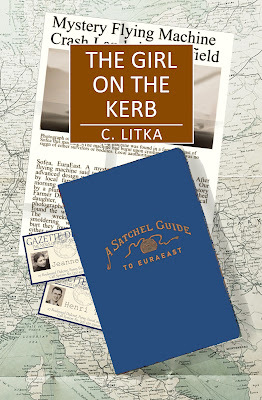
I have nothing exciting to write about this week, but that’s never stopped me before. So here we go. I think I will use this installment to update you on how things stand with The Girl on the Kerb. It was submitted it to the British SF publisher Gollancz in June. I don’t expect to hear back from them until sometime in the first half of 2023. In the meanwhile, I am sending letters to agents to see if they would like to represent this book to publishers.
I sent out 4 email queries on the first of July. To date I have received a rejection email on 27 July and another on 7 Sept. I have not heard from two others, but I think I can write those off as well.
On the 1st of August I sent out four more queries. I have received one form letter email rejection on 13 Sept. with three outstanding.
On the 1st of September I sent out four more. I received one form letter email rejection on 6 Sept, with the other 3 still outstanding.
That’s 4 confirmed rejections, 2 likely, and six still outstanding. I have enough names on my list of agents to keep at this for another 3 months, which will take me to December, after which I will likely call it a day.
However, while I am waiting, I’ve been tinkering with, and hopefully improving the story. Several reviews have mentioned that my ending was too abrupt. This maybe, in part, because I like to keep my endings open for sequels. Life goes on, but now off stage. I, don’t do happily ever after endings. However, in the case of The Girl on the Kerb, I wanted to keep the story going long enough after the story's McGuffin – the thing that drives the plot – is resolved in order to make it clear that it is the characters that I care about, not the McGuffin that I use to structure their story. This is true for all my stories. So in tinkering, I added 6,500 words to the last quarter of the book to show that life goes on after the McGuffin that brought the characters together. Though the ending, as always, is still open ended.
Now I’m reading through it yet again on my ebook reader to catch typos and to straighten up all the awkward sentences as I come across them. Hopefully by next week I will be completely comfortable with the story.
In other news: I hope to release The Aerie of a Pirate Prince either next week or the week after. And I have started a new story, Zar Lada, Taef Lang, and the Island of the Slumbering God. That’s my tongue in cheek working title of it. It takes up the story of Taef Lang, Lessie and Sella Rah, and Carz Fel where we left them at the end of The Prisoner of Cimlye. I’ll be happy with a novella. But to be honest, the story is still very vague in my mind, so I can’t guarantee that it will actually see the light of day.
Coming soon!
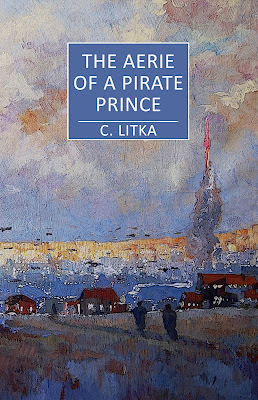
September 9, 2022
Shadows of Self Review
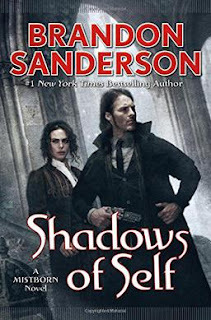
Shadows of Self A Mistborn Novel by Brandon Sanderson D
A “D” is not an official grade, as I usually don’t actually finish bad books. As I said in my review of The Alloy of Law, I wasn’t planning on reading this installment, but TOR gave this one away for free as well (promoting the 4th and final book of this series coming out in November) and somewhere I heard that Steris, Wax’s fiancee, and most interesting character, had a bigger role to play in this book, so I read on and on, long after I would likely have DNF’ed it for that reason only to find that she didn’t. I expect to get the third book in the series for free as well, but fool me twice... In any event, the review…
Waxillium Ladrain, “Wax” is superhero, with (magic) super powers. He's Batman with six-shooters, a shotgun, and a mistcoat instead of a cape, which is to say a semi-official vigilante, who goes around shooting bad guys bringing law and order to the city. This time the big bad gal is a shape-shifting demi-god gone “insane” who wants to free the citizens of the city from the manipulations of the local god, by stirring them into a frenzy of rioting by killing certain important people. Wax runs around trying to stop her, with the help of Miss-Goody-two-shoes, that is to say Marasi, his adoring fan, now a police officer, and his comic sidekick Wayne.
As I said in my review of The Alloy of Law, this is a superhero comic book without pictures. Sanderson tries to give Wax some depths as a character, having him reflect on what is is, and fails. Wax yam what he yam, and that’s an outback gunslinger lawman in a big city who is really good at shooting bad guys. I ended up skimming long stretches of this book as it drags on, and on. And on, setting up a killings or a superpower brawl every now and again.
Not having read the first three book series in the Mistborn books, I can’t say if the gods and demi-gods in this story appear in those books. If so, perhaps that is the appeal of this book to Sanderson’s fans. But they meant nothing and added nothing, beyond their roles in the story for me. There is a silly twist at the end that doesn’t seem to make a lot of sense, but I won’t spoil for you, dear reader, if after reading this review, you are eager to read it.
Long story short, Glen Cook’s “Garrett PI” featuring a private eye for hire, explore a variety of mysteries that sometimes touch on a similar theme as this story. And like in this story, he, with his various friends, must solve, and defeat the villains and without shooting dozens of people. (There are no guns in the story, despite the cover illustration.) Cook’s stories, however, featuring far more entertaining characters, are mostly set in TunFaire, a far more colorful city, and are written in a far more colorful and entertaining style. My advice; give this series a miss, and read Glen Cook’s Garrett PI stories. (In order, if you can.)
September 2, 2022
The New Paperback Versions
 The new collection
The new collectionNothing too pressing to report this week. The big news was that copies of my new paperback editions arrived. This redo of my paper books involved giving them all new covers with a standard design across the range, though not necessarily new artwork and a new, smaller size. I've posted about the inspirations and design process here: New Book Covers Again and show the full cover results here: https: New Book Covers. To quickly recap, I am thinking about ways to get my paper books into stores, and I wanted them to be what I think is a more typical size for trade paperbacks, 5.25 x 8" rather than my old size of 6 x 9" and I wanted matte covers like all the cool kids rather than the glossy ones I had previously used. Amazon will not let you change size or cover texture on published books -- it may be part of the bar code describing the product. In order to offer a new size I had to re-do all the books from scratch and unpublished the old versions.
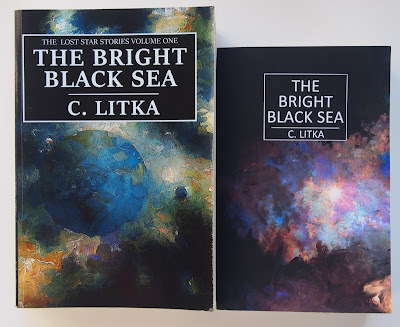
New cover art for the Bright Black Sea, though in fact I used the art from the first version of this book for the new cover. Because of the size of this book, and that of The Lost Star's Sea, with the significant downsizing of the page area, the font size had to be reduced to what you usually find on a mass market paperback. The alternative would have been to break each of the books down into three volumes. For The Bright Black Sea this would be no problem, since it was written as three books. It would be more problematical for The Lost Star's Sea as that was written as a series of novella length episodes. I decided against it for now, as it would most likely just create confusion.
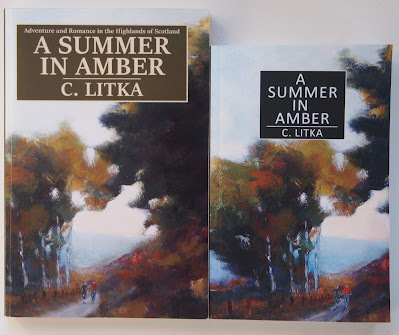
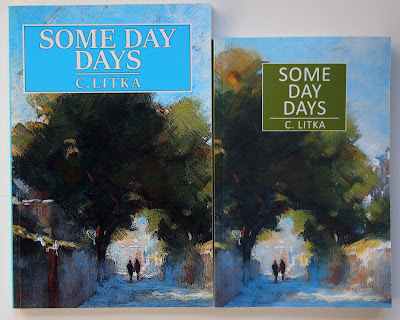
Above are two samples that kept the same artwork, but I found it interesting how I framed the artwork differently between the two editions. I guess there is no right way.
I am quite happy with these new editions. I like the matte cover, it has a velvety feel to it while still offering vibrant colors, which was my main concern. I like the new size, and I like the uniformity of design. I had abandoned that uniformity over the last couple of years, but I'm happy to go back to it. My old argument was that is was for "branding" purposes i.e. you knew a C. Litka book when you saw it. And I'm now back to that argument. The refrain one hears is that covers sell the book. That may be the case, but I've changed covers often enough over the last seven years, including new artwork, and have never seen any difference in sales. Your cover has to be seen for it to make a difference, and in publishing these days, being seen is the big challenge. Covers don't make a difference if they are not seen. My next challenge is to get my books seen. I'm working on that.
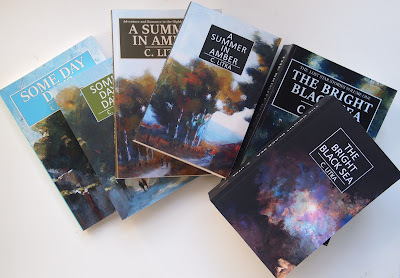
August 26, 2022
A Tale of Two Covers
I do my own covers. Not being an illustrator, I simply settle for mostly for mood. For the last few years I’ve put painting off to one side, as I found that I had run out of new ideas on what and how to paint. However, I want to get back into painting, so I decided to paint the cover for The Girl on the Kerb on the off chance that it won’t be picked up by a major publisher. Below is my pencil sketch for the paperback cover. I should note that this cover scene was decided on while the book title was still The Road to Eura. It is a scene from early in the story. I will probably have to rethink my cover with the new title.

Sorry about the quality of these photos, but it is hard to capture a faint pencil line. Also note that this is for the paper version, so I’ve done a quick mock up of how it would work out.
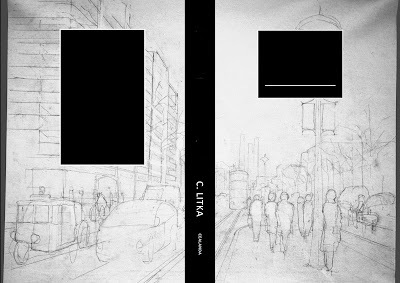
After sketching it, it took me several weeks to get around to actually painting. And then, I just did the sky with the three remaining towers of London’s Solar Age in the distance. A week or so later I worked in some details in the middle ground to arrive at the painting below.

At this point I realized that I was in trouble. This piece was falling into the uncanny valley of where it looked like I was trying to paint realistically, and failing badly. This is always the great danger of impressionism. You have to make certain that your viewers realize that you’re trying to paint without regard for realism. It’s loose and sloppy on purpose. The problem for me is always the middle distance. I try to paint scenes that include only the foreground and a background, That middle distance, where things get gradually smaller and less detailed is something I am terrible at. And here we had that middle distance in the receding buildings and tram. To eliminate as much of that as possible, I planned to bring the tram into the foreground. You can see the pencil sketch over the smaller version. And I hoped that the bare trees would cover up most the middle buildings.

A week or two later, I had a rainy Saturday on my hands, so I decided to tackle the painting for real. Now, I should say that a lot of what your are seeing is just roughed in, nothing was be final. Even so, I saw that I was in way over my head. And moreover, whatever I could salvage from this, would be so far from my original vision – as vague as it was -- that it wasn't what I wanted.. It just wasn't going to work. I tossed in my brushes and called it day on that painting.
However, since I had a much more immediate cover to paint, one for The Aerie of a Pirate Prince, I decided to tackle that cover by painting over this one. The scene I had in mind for that cover was much more in my wheelhouse. Below is the painting I came up with. This is the work of a couple of hours.
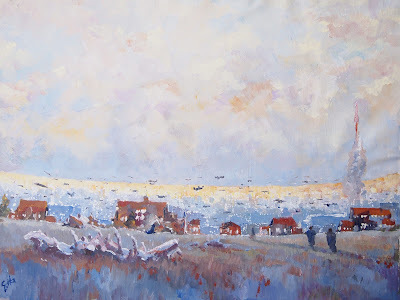
The scene is set on the rim of a large crater. The sun is setting behind us, illuminating the opposite crater rim. Mostly out of sight beyond the curve of the hill is a space port that is surrounded by warehouses. We have a rocket taking off on the right from the nearest section of the spaceport. The building in the foreground are small shops that repair containers, small ships boats, and such. Our two heroes are following a suspect who knows where the stolen goods have been taken.
Below is the final version for the paper back book after I worked on it in the photoshop style app, Gimp. I adjusted the color and contrast. added slight black outlines around brush strokes and made the rocket taking off brighter.
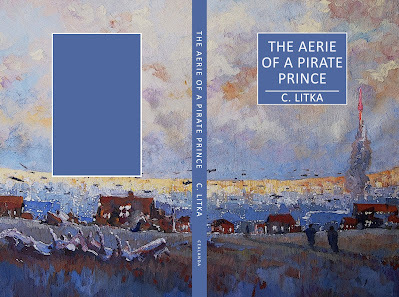
I will make the final version a little lighter than this one looks to be. I have to add the blurb in the box on the back cover as well. Long story short, I did end up with a useable cover, just not for the book I started to paint for. With the current title of The Girl on the Kerb, I almost have to paint the girl on the kerb for the cover... But I have time to work on that. In any event, look for the release of The Aerie of a Pirate Prince in the last half of September or early October.
